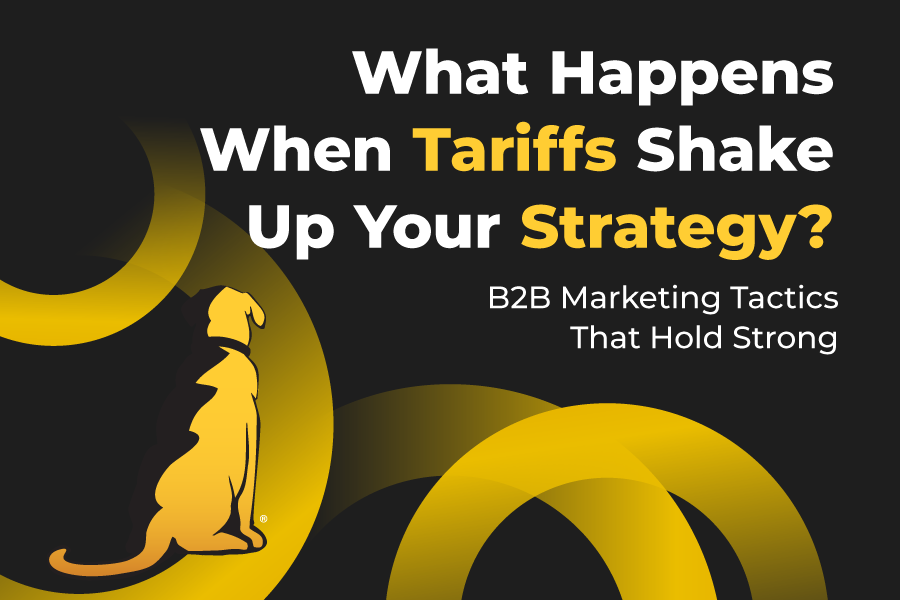
What Happens When Tariffs Shake Up Your Strategy?
In today’s volatile trade environment, B2B marketers can’t afford to sit back and hope for clarity on tariffs. From unpredictable rate hikes to sudden 90-day pauses, the only certainty is uncertainty. At YellowDog, we’ve been working closely with clients to build flexible, data-driven playbooks that keep revenue engines humming—even if costs shift overnight. Here’s how we’re helping brands stay ahead of the curve:
Build Robust Scenario Plans
Rather than drafting a single “set-it-and-forget-it” budget, we create three distinct scenarios—optimistic, moderate, and worst-case—so you can pivot without panic. In practice, this means:
Optimistic: No new tariffs, stable supply chains.
Moderate: A partial rollback of existing duties.
Worst-case: Current high-tariff regime remains indefinitely.
By working through each scenario, you’ll know exactly when to ramp up spend, shift channels, or conserve cash. As Rick Greenberg of Kepler notes, most clients are still in “monitor-and-prepare mode,” with very few making drastic cuts—yet they’re ready to act if the worst-case comes to pass.
Measure & Optimize Media Efficiency
Economic downturns often lead to lower CPMs, which can unlock performance marketing opportunities.
Here’s our playbook:
- Track CPM trends weekly across all paid channels.
- Shift budgets to high-ROI, performance-driven tactics (e.g., paid search, LinkedIn lead gen) when rates dip.
- Reevaluate brand vs. performance spend based on inventory exposure—financial-services clients, for instance, can lean into branding while manufacturing-dependent businesses shore up direct-response efforts.
Localize Your Messaging and Protect Reputation
Tariffs can stoke national-sentiment swings—Canadian shoppers, for example, have actively resisted U.S. goods unless they’re clearly “Made in Canada”.
To safeguard your brand:
- Highlight local sourcing in region-specific ads (as Kraft Heinz does in Canada).
- Maintain a “tariff-watch” dashboard that flags policy changes in real time.
- Train your communications team to adapt messaging within hours, not days.
Target Geographically Resilient Markets
When long-haul logistics get pricier, your best customers might be closer than you think. We’ve helped travel-and-tourism clients reallocate up to 30% of their spend into contiguous markets, capturing demand for nearby getaways as consumers “staycation” in response to rising costs.
Tailor Offers by Price Point
A 20% tariff on a $25-shampoo bottle barely registers—whereas a 20% uptick on a $30,000 machine can derail a purchase entirely.
To navigate this:
- Segment your catalog into high-ticket vs. low-ticket.
- Promote financing or flexible payment plans for expensive goods.
- Bundle smaller-ticket items into value packs to soften perceived cost increases.
Invest in Real-Time Intelligence
Tariff policies can flip in a single afternoon (we’ve seen 90-day pauses enacted with hours’ notice.
Arm your team with:
- Automated policy alerts via email or Slack.
- Weekly “flash” memos summarizing key legislative movements.
- Cross-functional war rooms—marketing, finance, and supply-chain leaders meeting biweekly to recalibrate tactics.
Putting It All Together
Tariff uncertainty doesn’t have to be a black swan. By embedding scenario planning, optimizing media spend, and localizing messaging, B2B brands can not only weather the storm but emerge stronger. Let’s work together to build marketing playbooks that adapt as fast as trade policy does—because when everyone else is paralyzed, you’ll be the one capturing market share.





